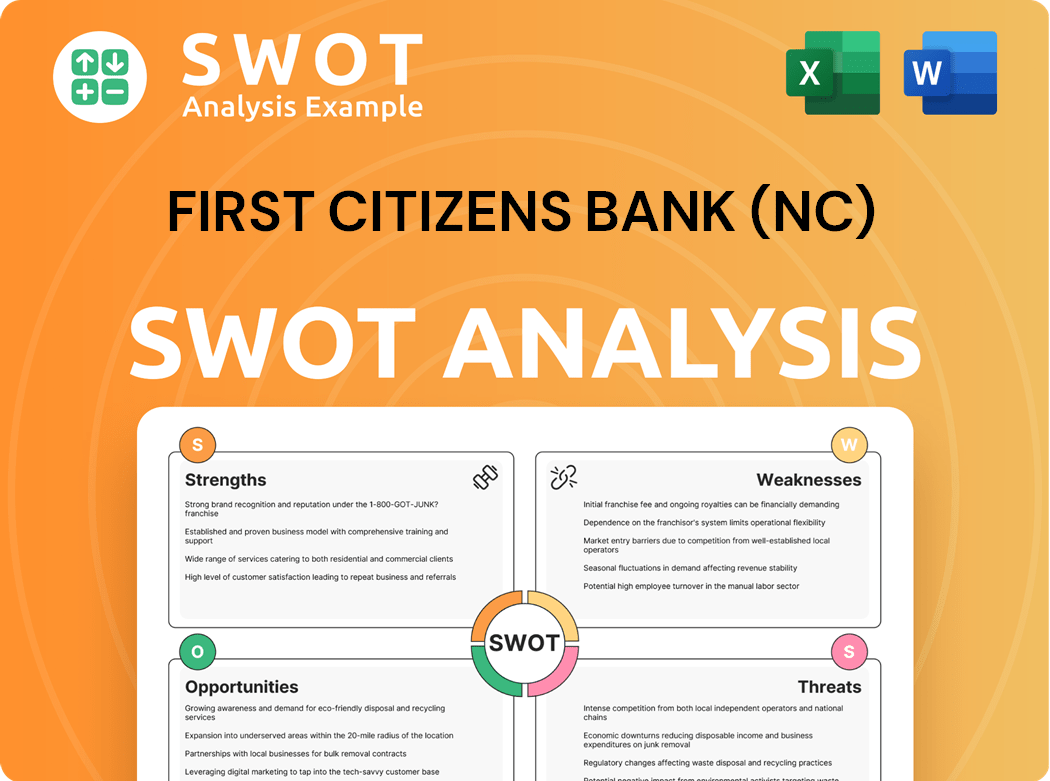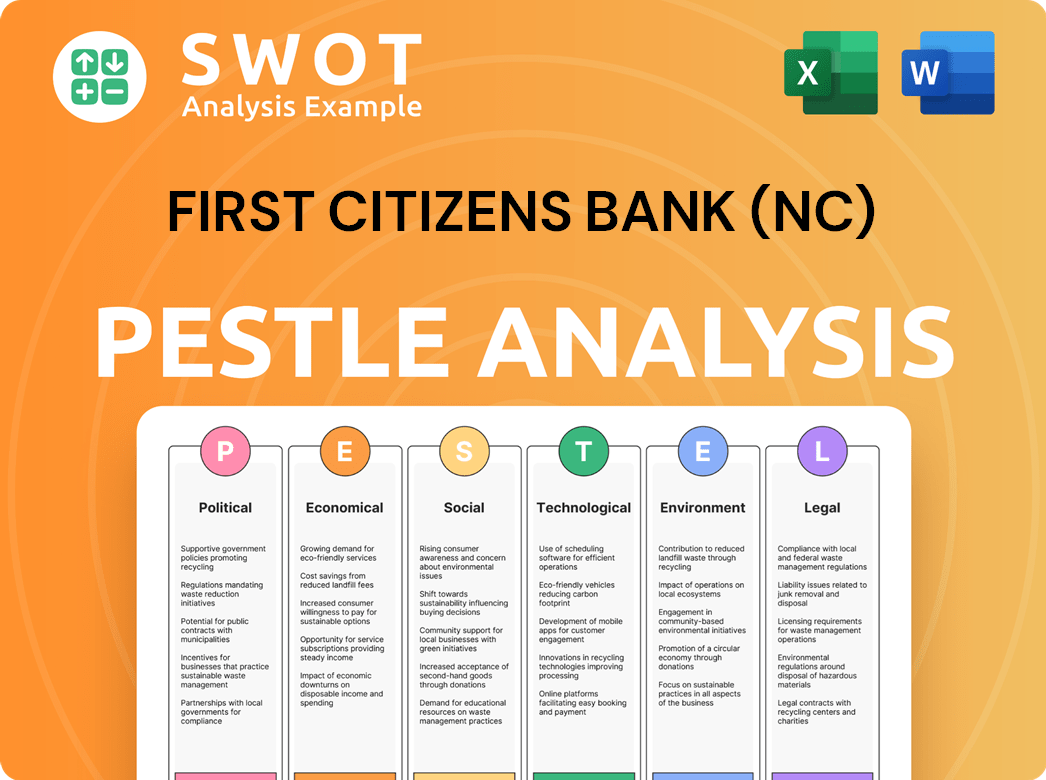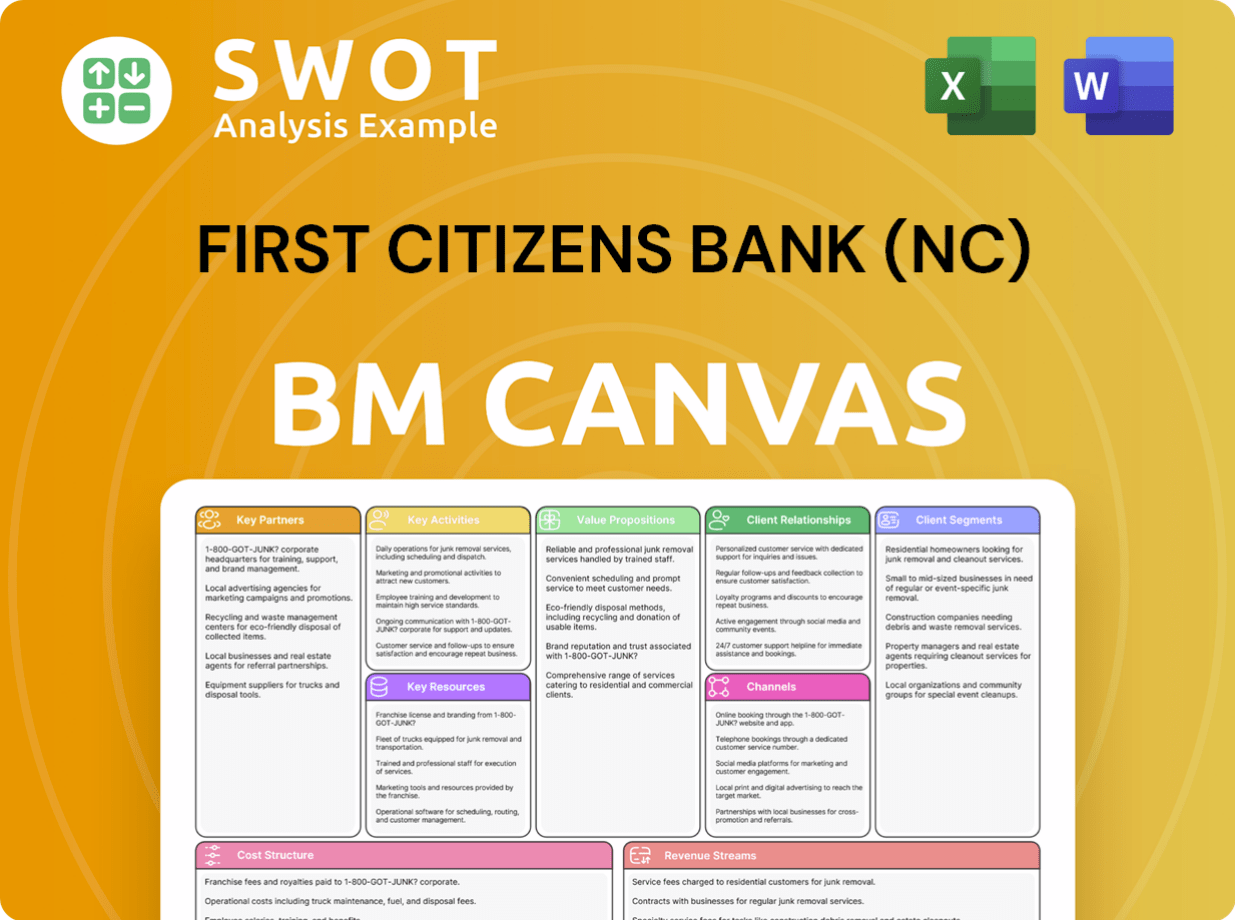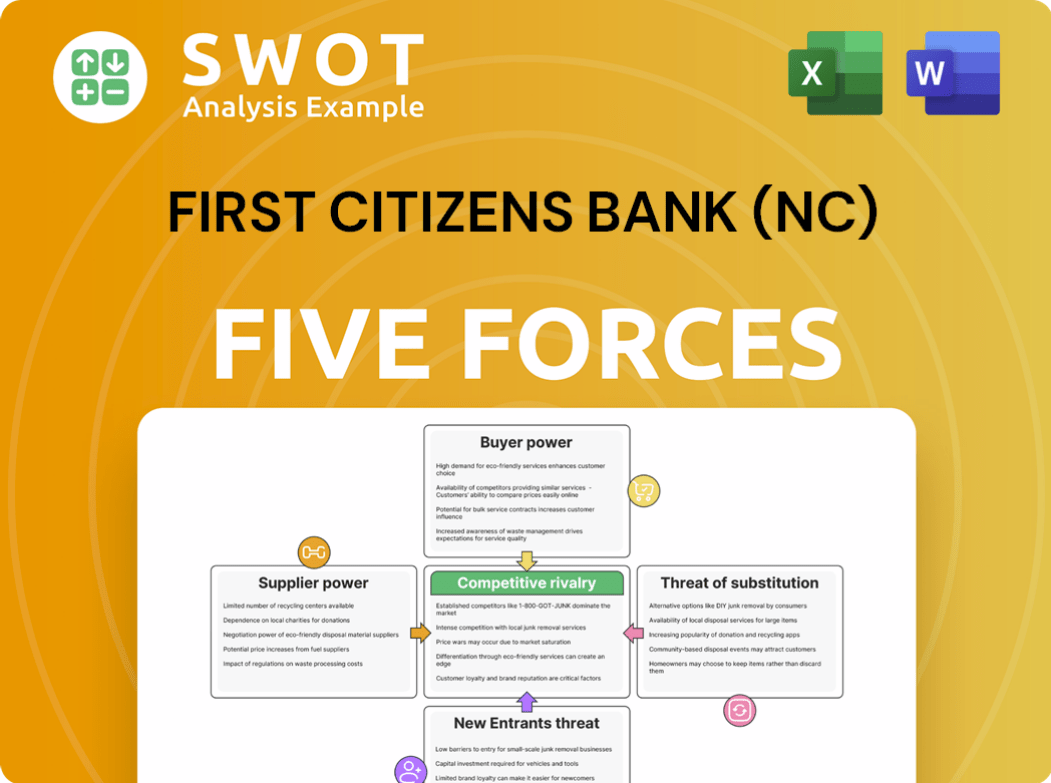First Citizens Bank (NC) Bundle
Who Really Owns First Citizens Bank?
Unraveling the ownership of First Citizens Bank is key to understanding its strategic moves and long-term vision. From its humble beginnings in 1898 to its pivotal acquisition of Silicon Valley Bank, the bank's ownership structure has significantly shaped its trajectory. This exploration will reveal the key players behind this financial powerhouse, including the enduring influence of the Holding family and major institutional investors.

First Citizens Bank's journey from a local North Carolina bank to a top 20 U.S. financial institution is a testament to its strategic decisions, including its recent bank acquisitions. Understanding the First Citizens Bank (NC) SWOT Analysis can provide further insights into its strengths and weaknesses. This analysis will help you understand the bank's ownership, its parent company First Citizens BancShares, and its position within the competitive banking industry.
Who Founded First Citizens Bank (NC)?
The story of First Citizens Bank, now a significant player in the banking industry, began on March 1, 1898, as the Bank of Smithfield. Allen K. Smith founded the bank in Johnston County, North Carolina, with an initial capital of just $10,000.
Smith served as the bank's president until 1906, setting the foundation for what would become a major financial institution. The bank initially focused on serving the agricultural community, establishing its roots in the local economy.
The leadership of First Citizens Bank changed significantly when Robert Powell Holding joined in 1918. He rose through the ranks, becoming president in 1935. Holding's leadership was crucial, especially during the Great Depression and World War II.
Founded in 1898 as the Bank of Smithfield, the initial focus was on agricultural customers.
Allen K. Smith was the first president. Robert Powell Holding became president in 1935.
Under Holding, the bank expanded, becoming North Carolina's second-largest by the time of his death in 1957.
The Holding family's involvement marked the beginning of long-term leadership and influence.
First Citizens Bank is one of the largest family-controlled banks in the United States.
Early agreements and shareholding details are not publicly available.
The early history of First Citizens Bank highlights its humble beginnings and the pivotal role of key leaders. The transition to the Holding family established a multi-generational ownership structure, which has significantly shaped the bank's trajectory. For more insights, you can explore the history of First Citizens Bank.
- Founded in 1898 with $10,000 in capital.
- Robert Powell Holding became president in 1935.
- By 1957, the bank had over $200 million in assets and 45 branches.
- The Holding family continues to have a significant influence.
First Citizens Bank (NC) SWOT Analysis
- Complete SWOT Breakdown
- Fully Customizable
- Editable in Excel & Word
- Professional Formatting
- Investor-Ready Format

How Has First Citizens Bank (NC)’s Ownership Changed Over Time?
The story of First Citizens Bank's ownership is a tale of family legacy and strategic growth. The bank, which adopted its current name in 1929, saw a pivotal shift in 1957 when Robert Powell Holding's sons took over leadership. This marked the beginning of an expansion phase, with the bank growing to 114 offices within a decade. The formation of First Citizens BancShares, Inc. in 1986 as the holding company further solidified its structure, paving the way for significant acquisitions.
The bank's growth accelerated, particularly after the 2008 financial crisis, with over 20 FDIC-assisted acquisitions. A major milestone was the 2022 acquisition of CIT Group, which doubled its assets. The acquisition of Silicon Valley Bank (SVB) in March 2023 was another game-changer, doubling its assets once more and propelling it into the ranks of the top 15 largest banks in the United States. As of Q1 2025, First Citizens BancShares, Inc. reports total assets exceeding $200 billion, highlighting its substantial presence in the banking industry.
| Year | Event | Impact |
|---|---|---|
| 1957 | Leadership Transition | Shift to Robert Holding's sons; Expansion phase begins |
| 1986 | Formation of First Citizens BancShares, Inc. | Established the holding company structure |
| 2022 | Acquisition of CIT Group | Doubled the bank's asset size |
| 2023 | Acquisition of Silicon Valley Bank (SVB) | Further doubled asset size; Ranked among top US banks |
The Holding family maintains a strong influence, owning approximately 20% of the stock and nearly 50% of the voting power. Frank B. Holding Jr. leads as Chairman and CEO, with Hope Holding Bryant as Vice Chairwoman, representing the third generation. Institutional investors also hold significant stakes. As of March 30, 2025, major shareholders include BlackRock Inc. (9.29%), Vanguard Group Inc. (7.12%), Harris Associates L.P. (4.97%), and Capital Research Global Investors (4.71%). First Citizens BancShares, Inc. is publicly traded on NASDAQ (FCNCA), reflecting its public status.
The ownership structure of First Citizens Bank combines family control with significant institutional investment.
- The Holding family's influence remains substantial.
- Strategic acquisitions have driven significant growth.
- Institutional investors play a key role in the bank's ownership.
- The bank is publicly traded under the stock symbol FCNCA.
First Citizens Bank (NC) PESTLE Analysis
- Covers All 6 PESTLE Categories
- No Research Needed – Save Hours of Work
- Built by Experts, Trusted by Consultants
- Instant Download, Ready to Use
- 100% Editable, Fully Customizable

Who Sits on First Citizens Bank (NC)’s Board?
The current Board of Directors of First Citizens BancShares, Inc. significantly influences the company's governance, particularly concerning its long-standing family ownership. The Holding family maintains a substantial presence and influence on the board, as detailed in the company's proxy statements. The board's composition and its relationship with major shareholders are key aspects of the company's structure, especially given the family's historical role in the Marketing Strategy of First Citizens Bank (NC).
First Citizens BancShares operates with a dual-class share structure, which gives the Holding family outsized control. As of March 3, 2025, there were 12,527,433 outstanding shares of Class A Common Stock and 1,005,185 outstanding shares of Class B Common Stock. This structure allows the Holding family, despite owning about 20% of the total stock, to control more than 50% of the voting power.
| Share Class | Shares Outstanding (as of March 3, 2025) | Voting Rights Per Share |
|---|---|---|
| Class A Common Stock | 12,527,433 | 1 vote |
| Class B Common Stock | 1,005,185 | 16 votes |
The Board of Directors typically recommends voting 'FOR' all director nominees and proposals related to executive compensation and the ratification of independent accountants. The annual shareholder meeting, where directors are elected, is usually held in April. Due to the Holding family's controlling voting power, there have been no significant recent proxy battles or activist investor campaigns that have altered the company's decision-making.
The Holding family's control is maintained through a dual-class share structure, ensuring significant voting power despite their percentage of total stock ownership. This structure allows the family to maintain control over key decisions, including the election of directors. Understanding the board's composition and the influence of major shareholders is crucial for investors and stakeholders.
- The Holding family controls more than 50% of the voting power.
- Annual shareholder meetings are typically held in April.
- No significant proxy battles have altered decision-making recently.
- First Citizens Bank ownership structure impacts corporate governance.
First Citizens Bank (NC) Business Model Canvas
- Complete 9-Block Business Model Canvas
- Effortlessly Communicate Your Business Strategy
- Investor-Ready BMC Format
- 100% Editable and Customizable
- Clear and Structured Layout

What Recent Changes Have Shaped First Citizens Bank (NC)’s Ownership Landscape?
Over the past few years, First Citizens Bank has seen substantial shifts in its ownership structure. The acquisition of Silicon Valley Bank (SVB) in March 2023 was a pivotal event, significantly increasing its market presence. Prior to this, the acquisition of CIT Group in January 2022 further solidified its position in the banking industry. These strategic moves have led to considerable growth, with total assets exceeding $200 billion as of Q1 2025.
In terms of ownership trends, First Citizens BancShares has actively engaged in share buybacks. The company repurchased 1,117,324 shares of its Class A common stock for $2.28 billion through March 31, 2025. This represents 8.26% of Class A common shares and 7.69% of total Class A and Class B common shares outstanding as of June 30, 2024. As of December 31, 2024, the remaining capacity under the Share Repurchase Program (SRP) was $1.84 billion. This reflects a strategy of returning capital to shareholders while integrating acquired entities.
| Key Ownership Developments | Details | Date |
|---|---|---|
| SVB Acquisition | Significantly expanded market footprint | March 2023 |
| CIT Group Acquisition | Elevated First Citizens into top-tier regional bank | January 2022 |
| Share Repurchase Program | Repurchased 1,117,324 shares for $2.28 billion | Through March 31, 2025 |
Institutional ownership remains a key factor, with BlackRock Inc., Vanguard Group Inc., and Harris Associates L.P. among the top holders as of May 2025. Insider holdings, primarily the Holding family, stood at 3.36% in May 2025, maintaining significant voting power through Class B shares. The bank's focus remains on maximizing growth opportunities, optimizing funding, and maintaining a strong capital position, suggesting continued strategic development.
The bank's ownership structure has evolved through strategic acquisitions and share buybacks. Institutional investors hold a significant portion of the shares. The Holding family maintains control through substantial voting power.
BlackRock Inc., Vanguard Group Inc., and Harris Associates L.P. are among the top institutional holders. These firms hold a significant percentage of the company's shares. Their investment decisions influence the bank's strategic direction.
First Citizens BancShares has actively repurchased its shares. By March 31, 2025, the company bought back a significant number of shares. This indicates a commitment to returning value to shareholders.
The bank is focused on growth, optimizing funding, and maintaining a strong capital position. This suggests a proactive approach to future opportunities. Strategic moves are likely to continue.
First Citizens Bank (NC) Porter's Five Forces Analysis
- Covers All 5 Competitive Forces in Detail
- Structured for Consultants, Students, and Founders
- 100% Editable in Microsoft Word & Excel
- Instant Digital Download – Use Immediately
- Compatible with Mac & PC – Fully Unlocked

Related Blogs
- What are Mission Vision & Core Values of First Citizens Bank (NC) Company?
- What is Competitive Landscape of First Citizens Bank (NC) Company?
- What is Growth Strategy and Future Prospects of First Citizens Bank (NC) Company?
- How Does First Citizens Bank (NC) Company Work?
- What is Sales and Marketing Strategy of First Citizens Bank (NC) Company?
- What is Brief History of First Citizens Bank (NC) Company?
- What is Customer Demographics and Target Market of First Citizens Bank (NC) Company?
Disclaimer
All information, articles, and product details provided on this website are for general informational and educational purposes only. We do not claim any ownership over, nor do we intend to infringe upon, any trademarks, copyrights, logos, brand names, or other intellectual property mentioned or depicted on this site. Such intellectual property remains the property of its respective owners, and any references here are made solely for identification or informational purposes, without implying any affiliation, endorsement, or partnership.
We make no representations or warranties, express or implied, regarding the accuracy, completeness, or suitability of any content or products presented. Nothing on this website should be construed as legal, tax, investment, financial, medical, or other professional advice. In addition, no part of this site—including articles or product references—constitutes a solicitation, recommendation, endorsement, advertisement, or offer to buy or sell any securities, franchises, or other financial instruments, particularly in jurisdictions where such activity would be unlawful.
All content is of a general nature and may not address the specific circumstances of any individual or entity. It is not a substitute for professional advice or services. Any actions you take based on the information provided here are strictly at your own risk. You accept full responsibility for any decisions or outcomes arising from your use of this website and agree to release us from any liability in connection with your use of, or reliance upon, the content or products found herein.